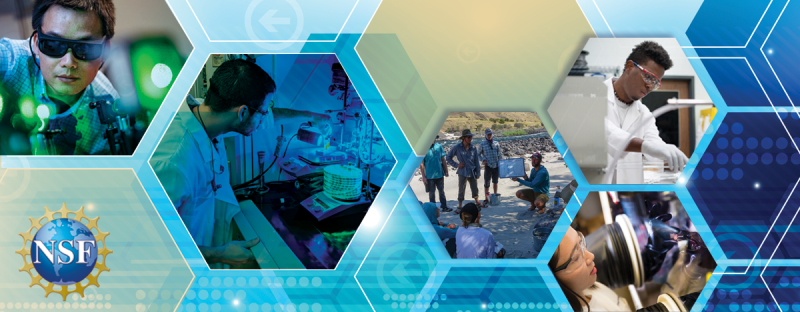NSF announces $120 million in funding to create 4 new Science and Technology Centers
The U. S. National Science Foundation has announced a $120 million investment over five-year to support four new Science and Technology Centers (STCs). Since program inception in 1987, the STC: Integrative Partnerships program has supported exceptionally innovative, complex research and education projects that have opened up new areas of science and engineering and developed breakthrough technologies.
“Scientific discovery is the engine that drives human progress and underlies all of the technologies that we benefit from today,” said NSF Director Sethuraman Panchanathan. “NSF’s Science and Technology Centers enable our most creative scientists and engineers to open new vistas of scientific inquiry and make the discoveries that will keep the U.S. in the forefront of scientific discovery. I am delighted to see the impressive originality in ideas and approaches in these new STCs and know they will have a tremendous impact.”
STCs conduct world-class research through partnerships among institutions of higher education, national laboratories, industrial organizations and other public or private entities, and via international collaborations, as appropriate. They provide a means to undertake groundbreaking investigations between disciplines and highly innovative approaches within disciplines. They also play a fundamental role in engaging, recruiting, retaining and mentoring next generation scientists and engineers from groups underrepresented in STEM.
The new centers will support advances in fields ranging from cell biology and complex materials to new applications of sound waves and environmental change. Each awardee will receive approximately $6 million per year over a five-year period, with the possibility of continual funding for up to five additional years. In addition to these latest awards, NSF supports 13 active STCs across the U.S.
The four Science and Technology Centers include:
-
NSF Science and Technology Center for Quantitative Cell Biology (QCB), led by researchers from the University of Illinois Urbana-Champaign; Harvard Medical School; and the J. Craig Venter Institute. The center aims to bring together expertise across cell and structural biology, chemistry, physics, engineering and computer science to develop whole-cell models that will transform our understanding of how cells function. Since cells are the fundamental units of all organisms, whole-cell models will provide important information about cellular functions in animals, plants, bacteria and fungi. Whole-cell models may also be used to compare the functions of healthy and diseased cells, leading to a better understanding of what goes wrong in diseased cells.
-
NSF New Frontiers of Sound (NewFoS) Science and Technology Center, led by researchers from the University of Arizona; California Institute of Technology; The City University of New York; the Georgia Institute of Technology; University of Alaska Fairbanks; UCLA; University of Colorado Boulder; Wayne State University; and Spelman College. Recent advances have revealed that topological acoustics (TA) phenomena possess extraordinary properties, such as extreme resistance to disorder, such that TA waves can be transmitted in obstructed domains without generating echoes or reflections. Exploiting surprising links between acoustics and quantum mechanics, the NewFoS STC will tackle grand challenges using TA focused on three main areas: quantum information science; the future of wireless communication; and applying TA to bypass remote sensing limitations in the physical world at scale for issues such as climate change.
-
NSF Center for Complex Particle Systems (COMPASS), led by a team of researchers from the University of Michigan; University of Illinois Urbana-Champaign; Northeastern University; University of Southern California; Wayne State University; Chicago State University; North Carolina State University; and Formative Evaluation Research Associates. The “ink” used in advanced manufacturing is shapable and yet consists of diverse, often non-spherical, particles. This “particle-based matter” is the focus of COMPASS, which will bring together a team of theoretical, experimental and computational researchers to develop the science and technology necessary to establish a much deeper understanding of particle-based matter as complex systems. By leveraging the relationship between complexity and functionality, the center aims to ignite a revolution in 3D printing and other forms of additive manufacturing with materials with customizable properties.
-
NSF Center for Braiding Indigenous Knowledges and Science (CBIKS), led by a team of researchers from the University of Massachusetts Amherst; Northern Arizona University; University of Maine; University of California, Santa Cruz; University of Washington; Montana State University; Western Washington University; Huliauapaʻa; Alaska Pacific University; New York University; College of Menominee Nation; University of Michigan; Gedakina; and SUNY College of Environmental Science and Forestry. CBIKS also includes partnerships with 57 Indigenous communities. The center aims to advance knowledge about environmental change and its effects on food and cultural systems at local and global scales by combining Indigenous knowledge with Western science in effective, ethical and novel ways. Eight regional research hubs include partners from multiple institutions across the social sciences, geosciences and environmental sciences, as well as Indigenous communities. CBIKS aims to advance not only what researchers know about interactions between the natural world and human societies, but also how to investigate and address related societal challenges.
For more information about NSF’s Science and Technology Centers, please visit nsf.gov.
